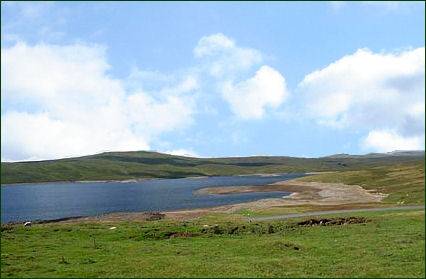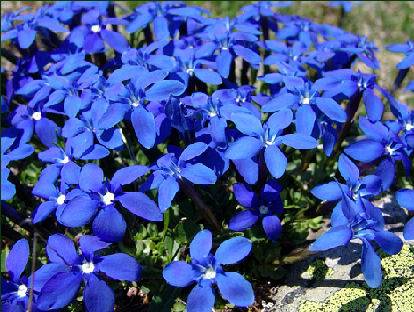Cow Green Reservoir
OS grid reference:- NY 813290
 Remote Cow Green Reservoir in Upper Teesdale measures 2 miles (3 km) long and was constructed between 1967 and 1971 for the Tees Valley and Cleveland Water Board mainly to supply water to the industries around the Tees Estuary and Darlington. The location was chosen for its large catchment area and mimimum disrruption to farming. The reservoir lies within the North Pennines Area of Outstanding Natural Beauty (Aids) and European Geopark.
Remote Cow Green Reservoir in Upper Teesdale measures 2 miles (3 km) long and was constructed between 1967 and 1971 for the Tees Valley and Cleveland Water Board mainly to supply water to the industries around the Tees Estuary and Darlington. The location was chosen for its large catchment area and mimimum disrruption to farming. The reservoir lies within the North Pennines Area of Outstanding Natural Beauty (Aids) and European Geopark.
The reservoir acts as a river regulation reservoir releasing water into the River Tees during dry conditions so that it can be abstracted further downstream. Cow Green Reservoir is also the largest reserve of wild brown trout in the North East.
Environmentally, this section of Upper Teesdale is of national importance and the plan to construct this reservoir was strongly opposed by conservationists at the time
. Their main concern was the protection of the unique rich flora and fauna of the district and especially rare alpine plants like the Teesdale violet. After a Parliamentary enquiry the scheme went ahead, about a tenth of this plant's habitat was destroyed by the completion of the reservoir.
Cow Green Reservoir is reached by a minor road from the B6277 from the Langdon Beck Hotel and from the car park a footpath leads south to the reservoir. Leaflets are available from local Tourist Information Centres or can be downloaded from the Internet.
Moor House-Upper Teesdale National Nature Reserve
 The remaining area was designated the Moor House-Upper Teesdale National Nature Reserve in 1969, from what was previously two separate nature reserves and is England's largest such reserve.
The remaining area was designated the Moor House-Upper Teesdale National Nature Reserve in 1969, from what was previously two separate nature reserves and is England's largest such reserve.
Moor House-Upper Teesdale National Nature Reserve covers 7,400 ha of the Pennine moors in the north of England and straddles Cumbria and County Durham. It extends from the upper edge of enclosed land in the Eden Valley, over Great Dun Fell(848 metres), Little Dun Fell and Knock Fell to the upper end of the reservoir. It extends southwards to the summit of Mickle Fell (788 metres) and eastward, down the River Tees, to High Force waterfall.
The reserve encompasses an almost complete range of upland habitats typical of the North Pennines, from hay meadows, rough grazing and juniper woods to limestone grasslands, blanket bog and the high fells.
As well the unique Teesdale Violet it contains the blue Spring Gentian (pictured right) as well as more common Pennine flowers such as rockrose, spring sandwort, mountain pansy, bird's-eye primrose and butterwort. The plants that originally colonised the North Pennines after the last Ice Age.
Upland birds such as curlew, golden plover and wheatear nest here in the spring and summer. There are interesting fossils of tree roots to be found especially on Knock Fell and old mine workings - both early bell pits and hushes, including the large Dun Fell hush. Extreme care must be taken near mine workings.
The North Pennines was designated as an AONB in 1988 and became Britain's first European Geopark in 2004.
Cauldron Snout
A short distance downstream from the dam is Cauldron Snout waterfall, situated well upstream of the High Force waterfall, It is more a long cataract than a waterfall, caused by the upper Tees passing over dolerite steps of the Whin Sill.
At 200 yards (180 metres) long, it is considered to be the longest waterfall in England. It is impressive by the scale of the British landscape, and attracts a lot of visitors, despite the 3-kilometre (1.9 mile) walk from the nearest car park at Cow Green Reservoir. The Pennine Way takes in Cauldron Snout.
